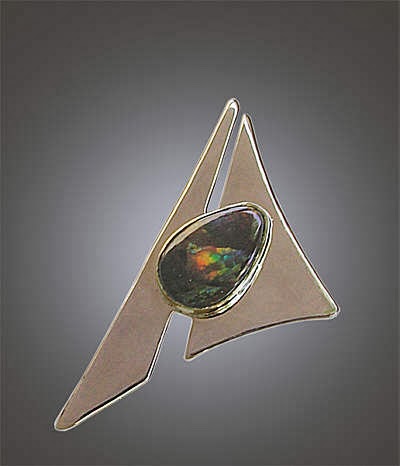The word Opal is adapted from the Roman term opalus, but the origin of this word is a matter of debate. However, most modern references suggest it is adapted from the Sanskrit word úpala.
References to the gem are made by Pliny the Elder. It is suggested it was
adapted it fromOps, the wife of Saturn and
goddess of fertility. The portion of Saturnalia devoted to Ops was "Opalia", similar
to opalus.
Another common claim that the term is adapted
from the Greek word, opallios.
This word has two meanings, one is related to "seeing" and forms the
basis of the English words like "opaque", the other is
"other" as in "alias" and "alter". It is claimed
that opalus combined these uses, meaning "to see a change in color".
However, historians have noted that the first appearances of opallios do
not occur until after the Romans had taken over the Greek states in 180 BC, and
they had previously used the term paederos.
However, the argument for the Sanskrit origin is
strong. The term first appears in Roman references around 250 BC, at a time
when the opal was valued above all other gems. The opals were supplied by
traders from the Bosporus,
who claimed the gems were being supplied from India. Before this the stone was
referred to by a variety of names, but these fell from use after 250 BC.
Fire opals are transparent to translucent opals
with warm body colors of yellow, orange, orange-yellow or red. They do not
usually show any play of color, although occasionally a stone will exhibit
bright green flashes. The most famous source of fire opals is the state of
Queretaro in
Mexico; these opals are commonly called Mexican fire opals. Fire opals that do
not show play of color are sometimes referred to as jelly opals. Mexican opals
are sometimes cut in their ryholitic host material if it is hard enough to
allow cutting and polishing. This type of Mexican opal is referred to as a
Cantera Opal. There is also a type of opal from Mexico referred to as Mexican
Water Opal, which is a colorless opal which exhibits either a bluish or golden internal sheen.
 Girasol
opal is a term sometimes mistakenly and improperly used to refer to fire opals
as well as a type of transparent to semi-transparent type milky quartz from
Madagascar which displays an asterism, or star effect, when cut properly.
However, there is a true girasol opal[ that is a type of halite opal, that exhibits a
bluish glow or sheen that follows the light source around. It is not a play of
color as seen in precious opal but rather an effect from microscopic
inclusions. It is also sometimes referred to as water opal as well when it is
from Mexico. The two most notable locations of this type of opal are Oregon and
Mexico.
Girasol
opal is a term sometimes mistakenly and improperly used to refer to fire opals
as well as a type of transparent to semi-transparent type milky quartz from
Madagascar which displays an asterism, or star effect, when cut properly.
However, there is a true girasol opal[ that is a type of halite opal, that exhibits a
bluish glow or sheen that follows the light source around. It is not a play of
color as seen in precious opal but rather an effect from microscopic
inclusions. It is also sometimes referred to as water opal as well when it is
from Mexico. The two most notable locations of this type of opal are Oregon and
Mexico.
Peruvian opal (also called blue opal) is a
semi-opaque to opaque blue-green stone found in Peru which is often cut to
include the matrix in the more opaque stones. It does not display pleochroism.
Blue opal also comes from Oregon in the Owhyee region as well as from Nevada
around Virgin Valley.
Opal Come From -Australia produces around 97% of the world's opal. 90% is called 'light opal' or white andcrystal opal. White makes up 60% of the opal productions but cannot be found in all of the opal fields. Crystal opal or pure hydrated silica makes up 30% of the opal produced, 8% is black and only 2% is boulder opal.
Another source of white
base opal or creamy opal in
the United States is Spencer, Idaho. A high percentage of the opal found there occurs
in thin layers.
Other significant deposits of precious opal
around the world can be found in the Czech Republic, Slovakia, Hungary, Turkey,
Indonesia, Brazil (in Pedro II ,Piaui),
Honduras, Guatemala, Nicaragua and Ethiopia.
In late 2008,NASA announced
that it had discovered opal deposits on Mars.











No comments:
Post a Comment